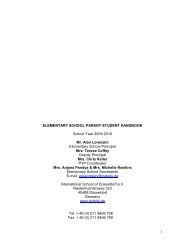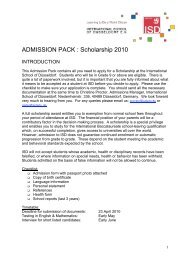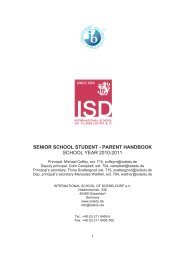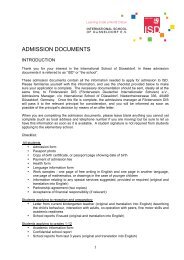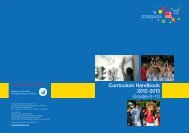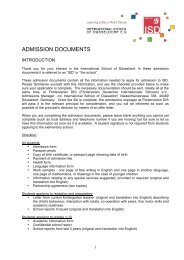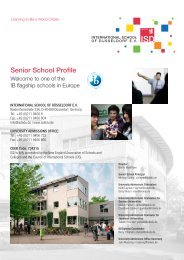Design Technology - International School of Duesseldorf
Design Technology - International School of Duesseldorf
Design Technology - International School of Duesseldorf
You also want an ePaper? Increase the reach of your titles
YUMPU automatically turns print PDFs into web optimized ePapers that Google loves.
• To help the students to understand the process <strong>of</strong> language learning<br />
and to understand and apply linguistic tools <strong>of</strong> meaningful<br />
communication<br />
• To develop curiosity, interest and enjoyment in the target language<br />
• To <strong>of</strong>fer insight into the life and civilization <strong>of</strong> the communities where<br />
the target language is spoken and encourage integration with the local<br />
community , where relevant<br />
• To encourage positive attitude towards speakers <strong>of</strong> other languages<br />
and develop an appreciation <strong>of</strong> other cultures<br />
Assessment<br />
Assessment is an integral part <strong>of</strong> our teaching and learning and a continuing<br />
process. Various methods, both formative and summative, are used to<br />
determine to what extent learning expectations have been met. Assessment<br />
criteria for the skills are established in rubrics and students are assessed in<br />
listening, speaking, reading and writing. Students are encouraged to evaluate<br />
their oral and written performance self-critically. Consistent, determined and<br />
constructive participation in class and regular homework are necessary<br />
throughout the course.<br />
The main criteria for language B courses are:<br />
Criterion A<br />
Speaking: Message and Interaction<br />
This criterion refers to the effectiveness <strong>of</strong> the speaker in communicating the<br />
required message and maintaining the flow <strong>of</strong> conversation.<br />
Criterion B<br />
Speaking: Language<br />
This criterion refers to the accuracy and fluency <strong>of</strong> the language used by the<br />
speaker.<br />
Criterion C<br />
Writing: Message and Organization<br />
This criterion refers to the effectiveness <strong>of</strong> the writer in communicating the<br />
required message, and the organization and cohesion <strong>of</strong> the text.<br />
Criterion D<br />
Writing: Language<br />
This criterion refers to the linguistic competence <strong>of</strong> the writer (vocabulary,<br />
register,<br />
grammatical structures).<br />
Criteria E and F<br />
Listening and Reading<br />
These criteria refer to the effectiveness <strong>of</strong> the listener to recognize,<br />
understand and interpret texts or dialogs.<br />
Typical assessment tasks include:<br />
• Prepared and spontaneous dialogs<br />
• Oral presentations<br />
22




